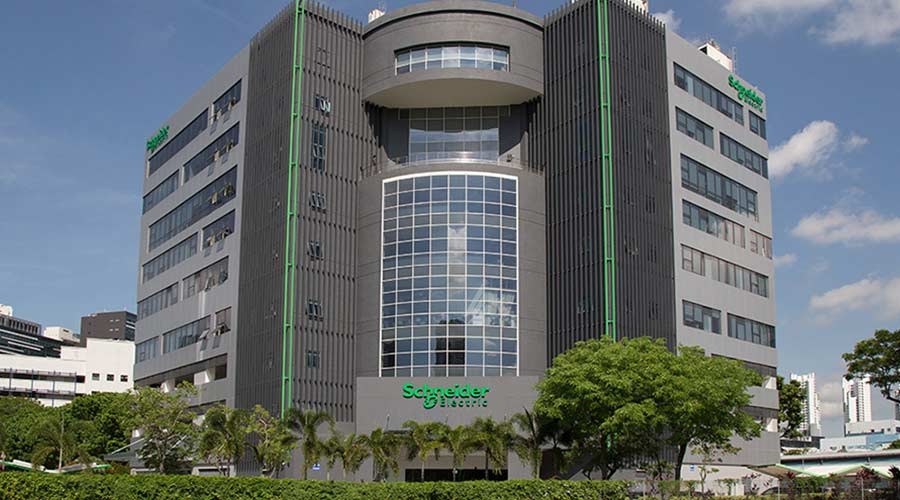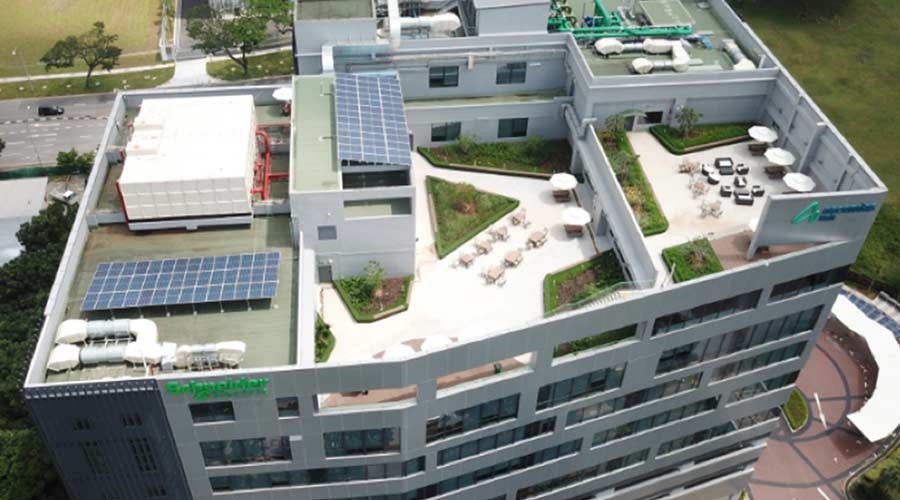Within Asia, Schneider Electric has set its sights on Southeast Asia (SEA), a growing bright spot for global businesses. SEA’s population of 660 million is the third largest in the world after China and India. Its middle class is expected to double from 135 million to 334 million consumers between 2019 and 2030, and electricity demand is projected to double between 2014 and 2025.
At the heart of the region lies Singapore, where Schneider Electric’s global energy expansion plans meet Asia’s business opportunities.
The company manages its operations across East Asia and Japan (EAJ)1 from its regional headquarters (RHQ) here, with an investment of €65 million (S$102 million) in 2015 to expand its operations, innovation as well as research and development (R&D) capabilities.
At the heart of the region lies Singapore, where Schneider Electric’s global energy expansion plans meet Asia’s business opportunities.
The company manages its operations across East Asia and Japan (EAJ)1 from its regional headquarters (RHQ) here, with an investment of €65 million (S$102 million) in 2015 to expand its operations, innovation as well as research and development (R&D) capabilities.
For its regional plans, the company identified five strategic pillars of growth: Core Businesses, New Market Segments, Digitisation, Services, and New Energy Landscape. Here’s how Singapore’s unique advantages support Schneider Electric’s growth across these themes.
A key regional hub to drive business development
Singapore’s strategic location and connectivity to other major cities make the city-state an efficient base for Schneider Electric to grow its market share in SEA. The company’s first pillar — the growth of its energy management and industrial automation core businesses — is reinforced by Singapore’s strengths in network logistics, analytics and transportation.
“Singapore has become a key hub for us in many areas our logistics hub in Singapore is one of our global hubs and is connected to other global hubs in Europe and the US,” says Mr Damien Dhellemmes, Country President of Schneider Electric Singapore.
The company’s RHQ in Singapore complements manufacturing and operational facilities in other SEA cities. Mr Leong calls this an “Asia-mentality”, a win-win strategy of partnering the entire SEA ecosystem to accelerate growth.
A central platform to reach diverse customers
Singapore also provides Schneider Electric with a regional platform to serve SEA’s diverse markets. This supports the company’s second strategic pillar, focusing on the development of new products and solutions to address new market segments.
“Right now, we are positioned in optimum segments with high quality offers. We see competitors offering types of products or solutions in price ranges where we are not present, and that’s where we want to accelerate,” says Mr Stephane Nuss, the company’s Vice President of Business Development for EAJ.
Through its Singapore RHQ, Schneider Electric drives a “geolocation” formula, customising its country-specific approaches to meet the different maturity levels of markets while creating entry barriers for potential competitors.
Enabling suppliers and customers alike to organise resources and talents, the Singapore RHQ facilitates centralised decision-making while allowing for late differentiation to adapt solutions to local standards, practices, and regulations for each spoke market, shares Mr Nuss.
A key regional hub to drive business development
Singapore’s strategic location and connectivity to other major cities make the city-state an efficient base for Schneider Electric to grow its market share in SEA. The company’s first pillar — the growth of its energy management and industrial automation core businesses — is reinforced by Singapore’s strengths in network logistics, analytics and transportation.
“Singapore has become a key hub for us in many areas our logistics hub in Singapore is one of our global hubs and is connected to other global hubs in Europe and the US,” says Mr Damien Dhellemmes, Country President of Schneider Electric Singapore.
The company’s RHQ in Singapore complements manufacturing and operational facilities in other SEA cities. Mr Leong calls this an “Asia-mentality”, a win-win strategy of partnering the entire SEA ecosystem to accelerate growth.
A central platform to reach diverse customers
Singapore also provides Schneider Electric with a regional platform to serve SEA’s diverse markets. This supports the company’s second strategic pillar, focusing on the development of new products and solutions to address new market segments.
“Right now, we are positioned in optimum segments with high quality offers. We see competitors offering types of products or solutions in price ranges where we are not present, and that’s where we want to accelerate,” says Mr Stephane Nuss, the company’s Vice President of Business Development for EAJ.
Through its Singapore RHQ, Schneider Electric drives a “geolocation” formula, customising its country-specific approaches to meet the different maturity levels of markets while creating entry barriers for potential competitors.
Enabling suppliers and customers alike to organise resources and talents, the Singapore RHQ facilitates centralised decision-making while allowing for late differentiation to adapt solutions to local standards, practices, and regulations for each spoke market, shares Mr Nuss.
A pipeline of quality talent to strengthen service delivery
Singapore’s educated workforce and business-friendly ecosystem support Schneider Electric’s fourth strategic pillar in service development, deepening the company’s service competencies through human resources and partnerships.
Testifying to the quality of specialised talent available in Singapore, Schneider Electric is deepening its R&D competencies in data centre and process automation, digitisation, and Industry 4.0 technology services. It set up a Machine Solutions R&D team in its RHQ, one of Schneider Electric’s four Machine Solutions R&D teams globally.
A dynamic startup environment in Singapore means Schneider Electric’s RHQ is plugged into a network which fast-tracks collaboration with industry players, customers, tertiary institutions and government agencies. The company has collaborated on digital infrastructure projects, including the zoo, military facilities, and transportation infrastructure, and partnered with multi-national corporations, government, and local startups to incubate innovation.
A future-forward lab to pursue innovation
Ranking first in the Asian Digital Transformation Index, Singapore’s digital-ready infrastructure accelerates Schneider Electric’s digitisation and new energy development efforts, which comprise its last two pillars of growth.
For instance, Schneider Electric’s Innovation Hub in Singapore pilots proofs of concepts to be developed and launched in global markets within six months. The company’s digitisation solutions are powered by its EcoStruxure platform, and include plug-and-play mobility, sensing, analytics and cybersecurity advancements connected through the Internet of Things (IoT).
Mr Leong explains that the Innovation Hub is “not just a showroom. It's actually a living lab where we are using everything that we are showing. Everything is real and we work continuously to improve it.” EcoStruxure solutions have been deployed in over 480,000 installations, connecting over 1.5 million assets in homes, data infrastructure and industrial buildings worldwide.
As an urbanised city-state, Singapore presents an ideal test bed for smart city projects. State-of-the-art projects coming out of Schneider Electric’s Singapore RHQ help the company build brand equity, awareness and recognition, while showcasing best practices and business solutions for developing markets in the region.
Testifying to the quality of specialised talent available in Singapore, Schneider Electric is deepening its R&D competencies in data centre and process automation, digitisation, and Industry 4.0 technology services. It set up a Machine Solutions R&D team in its RHQ, one of Schneider Electric’s four Machine Solutions R&D teams globally.
A dynamic startup environment in Singapore means Schneider Electric’s RHQ is plugged into a network which fast-tracks collaboration with industry players, customers, tertiary institutions and government agencies. The company has collaborated on digital infrastructure projects, including the zoo, military facilities, and transportation infrastructure, and partnered with multi-national corporations, government, and local startups to incubate innovation.
A future-forward lab to pursue innovation
Ranking first in the Asian Digital Transformation Index, Singapore’s digital-ready infrastructure accelerates Schneider Electric’s digitisation and new energy development efforts, which comprise its last two pillars of growth.
For instance, Schneider Electric’s Innovation Hub in Singapore pilots proofs of concepts to be developed and launched in global markets within six months. The company’s digitisation solutions are powered by its EcoStruxure platform, and include plug-and-play mobility, sensing, analytics and cybersecurity advancements connected through the Internet of Things (IoT).
Mr Leong explains that the Innovation Hub is “not just a showroom. It's actually a living lab where we are using everything that we are showing. Everything is real and we work continuously to improve it.” EcoStruxure solutions have been deployed in over 480,000 installations, connecting over 1.5 million assets in homes, data infrastructure and industrial buildings worldwide.
As an urbanised city-state, Singapore presents an ideal test bed for smart city projects. State-of-the-art projects coming out of Schneider Electric’s Singapore RHQ help the company build brand equity, awareness and recognition, while showcasing best practices and business solutions for developing markets in the region.








